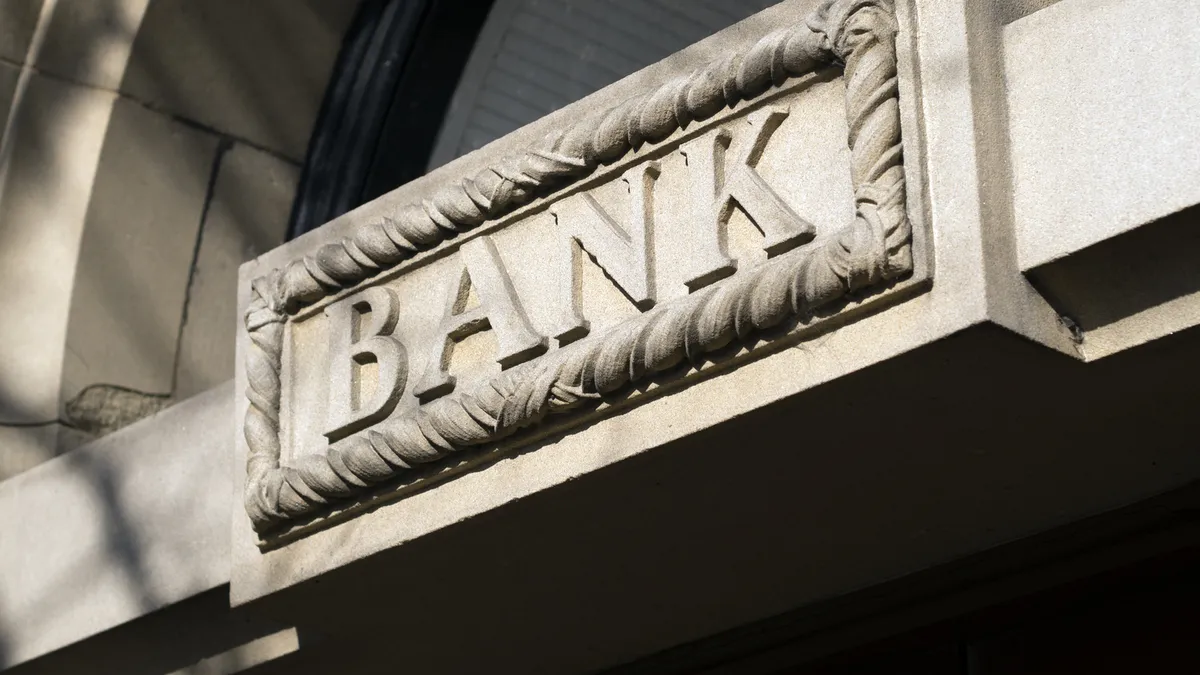The coronavirus pandemic has caused thousands of bank branches to temporarily close and limit hours and visits, as local governments enact social distancing measures to slow the spread of the virus.
The new normal has introduced bank customers and their employees to new habits and digital options, and some experts say banks are reevaluating the value of their branches and corporate offices as a result.
"With this forced mobile experiment of the COVID-19 pandemic fresh in their minds, I think it's going to accelerate timelines for taking action on the cost side," said Keefe, Bruyette & Woods (KBW) Managing Director Michael Perito on branch consolidation in the banking sector.
Against the backdrop of the coronavirus, banks are changing the way they operate their branches, shortening hours, limiting traffic and closing locations altogether, and customers are forming new habits as they adjust, said Paul Schaus, president, CEO and founder of consulting firm CCG Catalyst.
"If you closed one branch for four months and now everybody has shifted to using the other branches, do you really need to open it back up? You've trained your customers," he said.
Industry observers, including Jim Miller, vice president of banking intelligence at J.D. Power, say the coronavirus crisis is accelerating the shift from branch interactions to digital.
A July survey conducted by the data analytics company found that only 9% of respondents said they conducted a transaction inside a bank branch in the past week, compared to 29% who used a drive-through, 29% who used mobile check deposit and 33% who used an ATM.
Nearly one-fifth (18%) of respondents said that, after the crisis, they plan to use branches less than before, while 29% said they plan to use mobile more, and 24% said they'd hedge toward online banking.
"The longer customers feel that going to the branch is potentially unsafe and use digital channels to conduct their banking, the more the habit of not using the branch will become ingrained," Miller said.
Banks are picking up on the trend and have either hinted at or made official announcements about how they plan to change their branch strategies in light of the pandemic.
During an earnings call last month, PNC CEO Bill Demchak said the bank is reconsidering its branch strategy in light of changing consumer behaviors.
"What's clear is consumer behavior has changed, and in my belief, it has changed permanently with this adoption to digital," he said. "We'll have to adjust the way we serve our clients and it is likely that that will mean less physical space."
The bank, which has been consolidating branches for some time, applied with regulators to close 29 branches in August. The bank closed 16 in May, part of an earlier filing with the Office of the Comptroller of the Currency (OCC).
U.S. Bank also may accelerating its branch consolidation in response to increased usage of the bank's digital channels. The Minneapolis-based lender had targeted closing 10% to 15% of its retail locations for more than a year and a half. But now it's considering more.
"What's clear is consumer behavior has changed, and in my belief, it has changed permanently with this adoption to digital."

Bill Demchak
CEO, PNC Financial Services
"You have anywhere between 17% to 35% increases in digital activity occurring that used to occur in the branch," U.S. Bank CEO Andy Cecere said in May. "All of that saves expense, and we're going to continue to invest in that."
The OCC's acting chief, Brian Brooks, has cautioned against using the pandemic as justification for closing branches.
However, Miller said he expects more of the country's largest banks will decide, like PNC and U.S. Bank, to shrink their brick-and-mortar footprint.
"In most markets they have higher branch density, so the disruption to their customers who have to go to another nearby branch are minimal," he said. "Additionally, due to their investments in digital and a younger customer base, branch usage is lower than it is at smaller competitors. This will give them the ability to close branches and retain customers."
Deposits at U.S. banks have increased dramatically during the pandemic. Banks saw a $2 trillion surge in cash since the first virus cases were reported in January, according to data released by the Federal Reserve.
That means banks can afford to lose some deposits as they close branches, Miller said.
Deposits at U.S. banks totaled $15.47 trillion as of late July — up $2.2 trillion more than the $13.3 trillion banks had at the end of February, according to the Fed's data.
'Branch rationalization'
Decisions to pare office and branch space will continue as banks look to trim costs amid economic uncertainty, Perito said.
"Branch traffic was already down. It's never going to get back to where it was pre-pandemic, by and large, and I think that's where some of the branch rationalization will come into play," he said.
In KBW's latest Branch Spotlight Report, the firm estimates the U.S. banking industry is over-branched, and will likely to shrink by 20% to 30% as digital adoption continues to rise.
"That reduction was going to happen over the next 15 years before the pandemic. Maybe it's only five now," Perito said.
Branches won't be the only real estate to go. As employees and management become more comfortable with remote work, banks could also see their corporate offices downsize.
"Branch traffic was already down. It's never going to get back to where it was pre-pandemic."

Michael Perito
Managing Director, Keefe, Bruyette & Woods
KBW estimates banks had more than 70% of their employees working efficiently from home over the past few months, and are likely discussing their future office needs.
Another study by Accenture found that 61% of bank executives don’t expect all of their remote workforce to be called back to the office.
More than half (55%) of the survey's respondents said their firms are planning to deploy a physical, digital and hybrid workforce location strategy, and 42% said they expect to reduce their real estate footprint, Accenture found.
Bryn Mawr Bank, a $4.9 billion-asset bank based in Bryn Mawr, Pennsylvania, is already making such changes.
The bank disclosed that 40% of its staff, representing more than 300 of the company's almost 700 employees, will continue to work from home once offices reopen, the Philadelphia Business Journal reported last month.
Bryn Mawr said it plans to sell one building and terminate leases on two others by the end of the year, reducing its back-office footprint by 33,000 square feet. The bank also laid off more than 20 back-office employees in what it called "redundant positions" in June, the publication reported.
"They weren't a bank that was doing poorly and they still found a significant way of saving money," Perito said. "It really does come down to math. Banks are going to have to cut dollars somewhere. You don't want to cut revenue-producing people and you don't want to cut technology costs. Go down the line and physical occupancy costs, to me, appears to be the lowest-hanging fruit."
Shifting strategies
ConnectOne Bank, a $7.5 billion-asset regional bank with branches in New York and New Jersey, closed eight of its 22 branches during the last quarter and expects to close four more by the end of the year.
Like many other banks, ConnectOne Chairman and CEO Frank Sorrentino said the decision was based on customers’ increased use of digital, which was accelerated by the pandemic.
"We built out this ability to think more about our clients' needs relative to a hub office and get away from the branch-on-every-corner aspect of a lot of community banks," Sorrentino said.
"Like it or not, people driving by still believe that your [bank's] presence means their money's there."

Keith Brannan
CMO, Kasasa
While some banks may be second-guessing the "branch-on-every-corner" model for growth, there is still value in having a strong physical presence in a particular market, Keith Brannan, chief marketing officer at financial technology and marketing company Kasasa, said during an 11:FS Fintech Insider podcast last month.
"Having branches in some of these areas is actually a driver of your acquisition performance," said Brannan, who said a bank with 10 branches beats one with three every time, even if the two institutions were to run the same marketing campaign.
"Like it or not, people driving by still believe that your [bank's] presence means their money's there," he said. "Despite the fact that I think there is an over-investment in some branch areas in very competitive markets, in others, it's a service-level need that will continue to be there."
However, for banks looking to shed excess branches in an effort to cut costs, the coronavirus pandemic presents a unique opportunity, Schaus said.
"If you're going to make change to a bank, this is a good time to do it," he said. "People are more open to change right now."




















